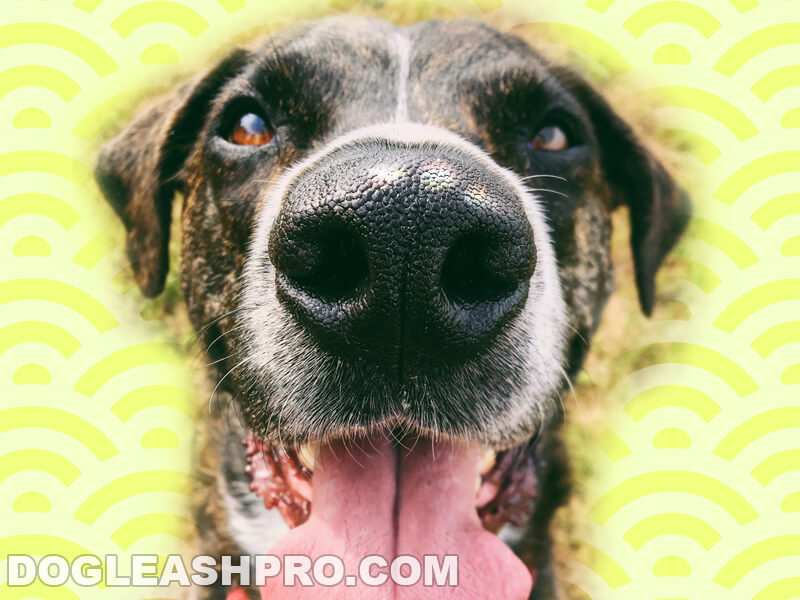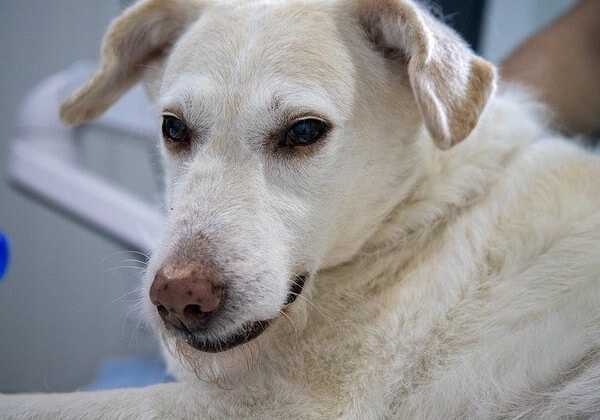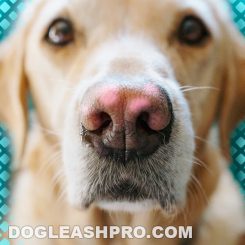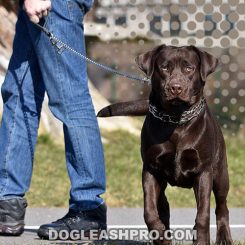
Your dog’s nose is usually all brown or black and may sometimes turn pink depending on the dog breed so when you notice a sudden white spot on his nose, it’s normal to start worrying and become concerned. What does a white spot on dog’s nose mean and what can dog owners do to help. We will discuss everything you need to know about the white spot on your dog’s nose and what you can do to help.
White spot on dog’s nose: There are many reasons why there may be a white spot on your dog’s nose. Some are benign and minor like having a pimple while others are more severe such as a bacterial or fungal infection, kennel nose, or discoloration of the skin and nose.
Keep reading to find out what dry white spot, white bump, and white crust on the dog’s nose mean.
Table of Contents
White Spot On Dog’s Nose: 7 Surprising Reasons!

Below are 7 reasons why your canine friends may have a white spot on their noses. While dry spot, bump, and crust are pretty common in dogs, it’s important that owners carefully monitor the white spot on the dog’s nose and contact the veterinarian as soon as they notice it.
1. White spot on dog’s nose due to whiteheads or pimples
Yes, you read that right! Dogs can have pimples and whiteheads just like us! Since their fur or hair follicles are almost the same as humans, they can also get pimples when these hair follicles are clogged.
It’s very common for the following areas in your dog’s body to have blocked fur follicles:
- Dog’s nose.
- Rear end.
- Stomach.
Our dog’s nose also has pores so when debris and dirt get trapped in there, it can cause the pores to clog and cause breakouts like pimples and whiteheads. This may be the small white spot you’re seeing on your dog’s nose.
This is why regular grooming is essential to wash away the dirt and debris from your dog’s nose, fur, stomach, chest, and other areas.
Be mindful to keep your dog’s food and water bowl clean every day. When our canine friends eat their food or drink water, their noses and chin (and even ears) touch the food bowl.
Plastic food and water bowl usually hold onto dirt and oil and when our dog’s muzzle touches it throughout the day, it can cause breakouts and pimples.
If the white spot on dog’s nose is due to breakout and pimple, try swapping out the plastic food and water bowl and replacing them with ceramic dog bowls or stainless steel options.
To treat the pimple on your dog’s nose, never try to pop the pimple on your dog’s nose yourself. Doing so can worsen the breakout causing it to become infected or inflamed. We highly recommend that you consult with your dog’s vet and ask for the best topical treatment option.
You may be interested in: Pink Spot On Dog’s Nose – What Does It Mean?
2. White spot on dog’s nose due to snow nose condition
While snow nose condition in dogs is when the dog’s nose goes from its normal dark brown or black to pink or white. While this condition mostly happens to dogs living in a colder environment, there have been reports that snow noses can happen to dogs in warmer climates as well.
So if you see a white spot on your dog’s nose, he or she may have a snow nose.
Snow nose usually affects the following dog breeds, although any and all dog breeds can have snow noses as well:
- Bernese mountain dogs.
- Golden retrievers.
- Labrador retrievers.
- Siberian huskies.
Luckily, snow nose condition isn’t something serious and it’s only a cosmetic change. It’s not painful and will not affect your dog’s daily life. Snow nose can disappear after a few weeks or months or it can be permanent, but regardless, there’s no need to be concerned or worried.
You might also like: Teacup Husky – Complete Guide!
3. White spot on dog’s nose due to kennel nose
Many puppies may have a white spot on their nose due to being in the crate or kennel for an extended period of time. Many owners that crate their puppies or dog for an extended period of time may notice their puppies or dogs developing a raw white bump or white mark on the nose.
That’s because dogs explore the environment around them with their nose. If they are crated for an extended period of time throughout the day, they may rub their nose against their crate to try to explore their surroundings outside of the crate.
Dogs that are kept in their crates all day may develop stress and anxiety since they are not getting the exercise they need such as simply walking around and exploring their environment.
Our furry friends need both mental and physical stimulation. Being cooped up in the crate or kennel leaves the dog no option but to try to nudge their way out with their nose. Keep in mind that our K9 friends also need social interaction which they aren’t getting by staying in the crate or kennel all day.
Constant rubbing of their nose against the crate and kennel can create a white spot on dog’s nose. Be sure to keep the white spot on the dog’s nose clean by gently cleaning it so it doesn’t get infected.
Try getting a bigger crate that allows your dog to move around easily inside or hire a dog sitter when you’re out at work or on vacation.
Many dog owners bring their dogs to a kennel dog stay while they are on vacation. We don’t recommend this as there are not many social interactions or mental and physical stimulation throughout the day.
If you’re looking for a kennel dog stay, do your research and find out how many hours throughout the day will your dog be able to play and exercise since most kennel stay keeps the dog all cooped up inside the kennel for hours each day.
When owners come back from their vacation and pick up their dogs, they often notice that their canine family members end up with bad health conditions and are often very sad and depressed.
You may be interested in: How to Crate Train A Puppy in 6 Steps
4. White spot on dog’s nose due to Nasal Hyperkeratosis
Canine nasal hyperkeratosis occurs when your canine friends produce too much keratin and this extra keratin creates a crusty, hard, and dry layer on your dog’s nose. In most cases, the layer is not too noticeable, but in severe cases, this crusty and hard layer can grow as much as one inch.
If nasal hyperkeratosis occurs, you may notice white bumps on your dog’s nose. Canine nasal hyperkeratosis is not uncommon and can be chronic so owners will need to treat it for the rest of their furry friend’s life. This condition can occur in all dog breeds as early as adulthood.
Be sure to consult with your vet and what the best treatment would be for the white spot on your dog’s nose due to nasal hyperkeratosis. Most vets will recommend a natural moisturizer for dry, crusty, and cracked skin. In severe cases, vets may even prescribe antibiotics or even steroids to treat the inflammation from the extra keratin buildup.
Your vet may have to carefully cut away the extra keratin buildup if it becomes too much on your dog’s nose.
5. White spot on dog’s nose due to canine vitiligo
A white spot on dog’s nose can also occur when dogs get canine vitiligo. Canine vitiligo is a skin condition that is pretty rare. Your dog’s nose can lose its natural black or dark brown pigment and white spots may start to appear.
Canine vitiligo can also appear on the dog’s lips, face, skin, and coat. It usually starts as tiny white spots on the dog’s face and nose and then spread to other areas like the coat and paw pads. It may take up to a total of 6 months from when the first white spot appears to fully spread.
Thankfully, like the snow nose condition, the white spot is only cosmetic and it will not affect your dog’s daily life. There is also no discomfort. Over time, the white spots on dog’s nose may gradually grow larger or slowly disappear.
Canine vitiligo is said to be hereditary and dog breeds that are prone to vitiligo are:
- Golden retriever.
- German shepherd.
- Yellow labrador.
- Siberian husky.
- Daschund.
- Rottweiler.
- Irish setter.
- Doberman pinscher.
- Old English sheepdog.
6. White spot on dog’s nose due to Pemphigus Foliaceus or PF
Pemphigus Foliaceus or PF is an autoimmune disease that is most commonly affects middle-aged dogs. Dogs may get yellow pustules or scabs on the face, head, and ears. Many believe that the following causes pemphigus foliaceus in dogs:
- Viral infections.
- Genetic predisposition.
- Prolong UV or ultraviolet light exposure.
Dog breeds that are prone to PF include Akitas and Chow Chows. To properly diagnose PF in dogs, a skin biopsy is required. If PF is mild, then it can be treated with either topical steroids or corticosteroids. These treatments will help treat PF and dogs usually respond well to them.
You might also like: How To Cure Parvo Without A Vet For Your Dogs
7. White spot on dog’s nose due to Discoid Lupus Erythematosus or DLE

Discoid Lupus Erythematosus or DLE is another common autoimmune disease in dogs. This disease affects the dog’s skin and usually occurs around the dog’s nose. You’ll notice lesions, swelling, or changes in color on the dog’s nose. DLE can essentially cause the dog’s nose to change from its natural black or dark brown color to white spots or white marks.
In addition to the dog’s nose, DLE can also occur around the dog’s skin, eyes, and lips.
Currently, no one knows what causes DLE in dogs, although many believe that it could be hereditary or due to environmental factors.
If you suspect your dog has DLE, be sure to contact your vet right away. The vet may prescribe topical creams or gels to alleviate the discomfort and reduce the swelling. Your vet may also ask that you reduce your dog’s exposure to the sun as too much sun can make this condition worse.
DLE may affect your dog’s quality of life since he or she may be required to stay indoors as much as possible and away from the sun.
How to treat a white spot on dog’s nose?
Fortunately, most white spots, white marks, or white bumps on your dog’s nose will go away within a few days or weeks and do not require medical intervention. However, to err on the side of caution and safety, we highly recommend that you bring your dog to the vet as soon as you notice the white spot growing or replicating throughout your dog’s nose.
If it’s minor like a snow nose or a pimple, at least you know the cause of the white spot on your dog’s nose and if it is more severe, then proper and timely diagnosis will prevent the condition from getting worse and you’ll know the right treatment option for the white spot.
Expect the following type of testing in order to properly diagnose the white spot on your dog’s nose:
- Allergy testing.
- Blood work.
- Scraping the white spot or affected tissues.
- Biopsy.
Your dog’s vet may prescribe the following treatment for the white spot on your dog’s nose:
- Anti-inflammatories for allergies.
- Moisturizing cream or balms for the dry white nose.
- Antibiotics for bacterial or fungal infections.
Depending on the reasons behind the white spot on the dog’s nose, you can expect dietary, behavioral, or environmental changes to your dog’s life.
Can I put Neosporin on my dog’s nose?
When you take a look at the ingredients in Neosporin, you’ll be glad to know that the ingredients are generally safe for dogs. This is important because you are probably aware that dogs like to lick their nose, especially when they know something is on it.
Before you decide to use Neosporin on your dog’s nose, consult with your vet first and ask if it is alright to do so. Neosporin is not always the solution to all nose wounds and white spots on a dog’s nose.
If your vet agrees that you can use Neosporin, be sure to only apply a tiny small amount to the affected area. In this case, if your dog scrapes his nose which caused a white mark, apply a small amount to that specific white spot. Licking and ingesting a small amount of Neosporin should be fine, but too much can be problematic.
Before you apply the Neosporin, be sure to clean the white spot on the dog’s nose first. You can use lukewarm water and with a towel, gently clean away the dirt and debris.
You’ll want to apply the Neosporin when your dog is tired and ready for bed. Otherwise, your pooch may naturally lick their nose which can cause an infection or prolong the healing time.
Be sure to monitor the injured nose closely and if the white spot on the dog’s nose worsens, take them to the vet immediately.
White spot on dog’s nose: Is it cancer?
It is very rare for dogs to have nasal cancer. Nasal cancer is so rare that it only affects less than 2% of all canines. Even if there is a white bump on dog’s nose, it might not be cancer. Be sure to err on the side of caution and bring your pooch to the vet to confirm the white spot isn’t cancer.
In severe cases where you see blood, pus, or mucus discharging from your dog’s nose or your dog is experiencing bone erosion on the nose, you’ll definitely want to bring them to see the vet as soon as possible.
Final thoughts
As you can see, most white patch on dog’s nose or white dot on dog’s nose are common and not too concerning. But for your peace of mind, it’s always best to consult with your dog’s vet and confirm the white spots, marks, or bumps you see on your dog’s nose.
DISCLAIMER: THIS WEBSITE DOES NOT PROVIDE MEDICAL ADVICE
The information, including but not limited to, text, graphics, images and other material contained on this website are for informational purposes only. No material on this site is intended to be a substitute for professional veterinary advice, diagnosis, or treatment. Always seek the advice of your veterinarian or other qualified health care provider with any questions you may have regarding a medical condition.
Resources:
https://www.nevetdermatology.com/common-skin-diseases-affecting-nasal-planum-of-dogs/
https://pubmed.ncbi.nlm.nih.gov/29076573

With over five years of specialized experience as an animal writer, my expertise lies in dog nutrition, health, behavior, grooming, and training. I am dedicated to delivering helpful and informative content that caters to the well-being of our furry friends. My primary goal is to empower pet owners with knowledge and ensure our canine companions thrive in health and happiness. In my free time, I love volunteering at local dog rescue centers.








